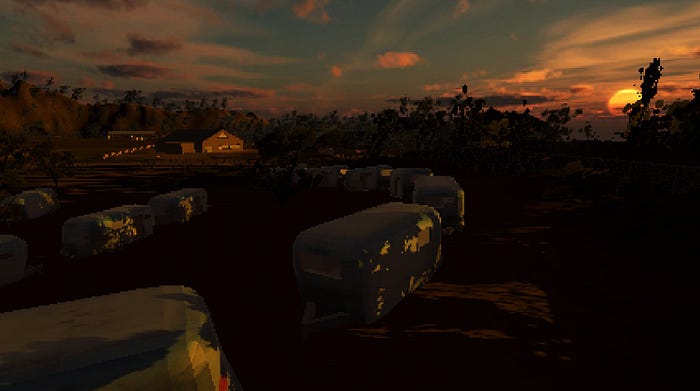The Merciful Horror of Sagebrush
A thoughtful exploration of despair, complacency, and truth

In the final weeks of March, 1997, 39 followers of the Heaven’s Gate cult committed suicide in California.
The followers believed they were leaving their human vessels behind in order for their souls to journey aboard a spaceship that would trail a comet into heaven. Male members of the group underwent voluntary castration, the more sincere members believing that a genderless life awaited them after suicide and removing unneeded body parts brought them closer to heaven.
In the low-poly horror walking simulator Sagebrush, the player is treated to a similar look into the chemistry and devotion of a mass suicide cult. Set in Albuquerque, New Mexico, Sagebrush takes place on the fictional Black Sage Ranch, the site of the 1993 Perfect Heaven mass suicide. Gameplay is exploration based but entirely lonely, playing a silent protagonist that wanders through the remains of the ranch as the details of the final days of Perfect Heaven are recounted.
The details are presented through typical walking simulator and horror tropes: letters, minute details, posters, diaries, journals, and tape recorders inform the player about the pieces of information that made up the daily lives of those who lived on the ranch.

Similar to Paratopic (another low-poly horror title I adored), Sagebrush’s affectations are in its simple design. Set against muted greens, reds and browns (again, similar in look and tone to Paratopic), the horror and dread of the game isn’t presented through monsters or jump scares but through music, atmosphere, sound effect and written detail. Despite the game only being an hour and a half long, it was as atmospheric as horror gets, with every important detail sliding home through the well done narration and well written letters and journal entries. Though the concept of the death cult has been explored before in video games and film, Sagebrush has a gentle, almost reverent take on why a group of lost and lonely people would give themselves over to a sadistic, perverted, charismatic leader in the middle of the desert.
Despite having a general idea of what I was walking into from the earliest moments of the game, Sagebrush nails its final moments by presenting the cult’s horrific truths with poignant humanism. Upon learning about the carnal brutality that the cult leader “James” requests of his followers, I was overcome with a terrible sadness. Reading through the journals of the people who lived and worked in the cult, it becomes apparent that they were looking for the same thing that all of us are looking for: meaning, and belonging.

Sagebrush is a thoughtful look at despair, complacency, and truth. Behind the rust-colored buildings and overgrown fields is a place where the people who lived there believed they were building their lives toward a relieving truth. As the player makes their way through the buildings, digging through every horrific detail of a recent past, the game’s final moments show that these sorts of pains are never fully recovered from.
This game is impressive, short and sweet, and another mark in the recent trend of low-poly ‘90s looking horror titles (a trend that I hope picks up steam and continues). It’s well worth its meager price on the Nintendo Switch, and should be a delightful afternoon playthrough for any fan of the genre.
